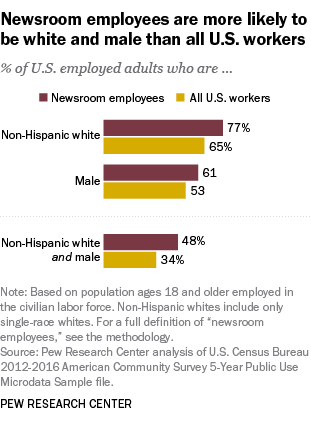The conversation about race in newsrooms isn’t new. In fact, more than 40 years ago, the American Society of Newsrooms Editors (ASNE) pledged that by the year 2000, newsrooms would be as diverse as the greater population in the U.S. This pledge has been left unfulfilled, however, and is now more than 20 years overdue.
News organizations today continue to lack the diversity of the country as a whole, according to a 2018 Pew Research Center study. Whereas 65% of the overall workforce in the U.S. is non-Hispanic white, for example, this number rises to 77% in newsrooms.

Three experienced journalists — all women of color — recently launched a new initiative to address this void in the media industry. It’s one that cofounders Selymar Colón, president and editor in chief of Frame ONE Strategies, Ana Campoy, deputy finance and economics editor at Quartz, and ABC ‘Nightline’ producer Jasmine Brown have experienced firsthand themselves. Called Diversifying Journalism, or DiJo, the project aims to advance the inclusion of voices of color among both newsroom employees and sources in journalists’ reporting.
“[Diversity] has a direct impact on the journalism that we produce in our newsrooms and who writes it. We need to have diverse voices and perspectives to give the reader a full account of the world,” said Campoy. “It is not going to happen spontaneously. This is a concrete way in which we can help.”
[Read more: Key takeaways for improving the representation of women in the news]
As newsroom veterans, Colón, Campoy and Brown are closely familiar with the heavy workloads and tight deadlines many of their fellow reporters have. It’s a reality that can lead journalists to seek out easy-to-find sources and experts to incorporate in their coverage, pushing their diversity to a secondary consideration, they explained. They’ve witnessed how this lack of diversity only gets worse, too, the higher up in the newsroom you go. A 2018 survey from ASNE revealed that while non-white journalists comprised only 22% of the workforce at print and digital publications, this drops to 18% in leadership positions.
The DiJo team kickstarted their work by releasing two surveys to crowdsource POC journalists. The newsroom staff survey aims to help hiring managers find experienced, qualified journalists. The experts survey will help journalists identify POC experts to include as sources in their reporting.
The team will vet the names they receive through the surveys, and put together two databases for journalists to use as a resource. The databases will serve not only as a tool for journalists and hiring managers, but also as a medium for fellow journalists to initiate mentorship and networking.
Their efforts come amid an increased push across the news industry to address issues of diversity, equity and inclusion in the newsroom. Spotlight PA created a database for journalists in Pennsylvania. On a larger scale, the Democracy Fund has created a Journalism DEI Wheel to help funders inform grantmaking for diversity, equity and inclusion.
”Since the summer of 2020, many newsrooms have started to reckon and publicly announce diversity initiatives. Some were strengthening what they had, others were starting from scratch,” said Colón.
[Read more: The Washington Post is building a newsroom that looks like America]
Colón, Campoy and Brown met during a fellowship with the Nieman Foundation last year. “I got a glimpse at how diversity can be organic and authentic,” Campoy wrote of her experience. “During the year we spent together, our differences made our discussions richer, more nuanced, and, yes, more complicated. It was like peeking through a kaleidoscope that constantly shifted my perspective, making me reflect on my bias.”
The three journalists will return as Neiman Visiting Fellows this year to build out their initiative. They plan to develop an interface for their databases during the 2021 fellowship, and leave with a prototype that they can beta test with media companies. After the testing period, newsrooms across the country will have access to the databases to help them acquire diverse, reliable sources.
Ultimately for the DiJo team, diversity is more than just about numbers — it’s the ability to understand the differences between each other to better your overall community.
“The biggest concern as journalists is that we want newsrooms in the U.S. to be representative of the communities they report on,” said Colón. “There is a lack of diversity because we don’t go out there and look for these professionals. They are out there, you just need to take an extra step to find them.”
Naomi Ludlow is an intern with IJNet.

